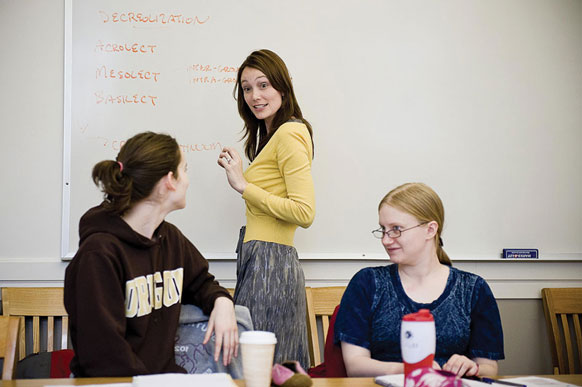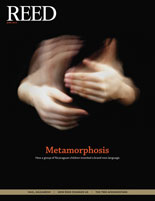
IRIS login | Reed College home Volume 92, No. 2: June 2013
Birth of a Language (continued)

Acrolect acrobatics: Kara Becker, assistant professor of linguistics, discusses code-switching in Linguistics 330, Contact Languages, with Katelyn Best ’13 (left) and Rosemary Ingham ’13 (right). Photo by Leah Nash
![]()
Katelyn’s project posed a dozen headaches. Although she was proficient in French and Spanish, she had no experience with sign languages—certainly not with ISN, and nor, for that matter, with ASL. What she needed was an informant—a native speaker who could give her insights into the grammatical structure of ISN by demonstration. Traveling to Nicaragua was impractical but, fortunately, Katelyn tracked down a deaf woman in Maine whose first language was ISN. Katelyn spent a week in Maine over winter break staying with Kegl and communicating with her informant, Sayda, a 25-year-old woman from Managua who had been profoundly deaf since birth. Although ISN is her first language, she also knows ASL and can read and write Spanish.
To prepare for her sessions, Katelyn took a crash course in ASL so she could ask Sayda about how ISN worked. After the first couple of sessions, however, she altered the format because she worried that Sayda was trying to accommodate Katelyn’s rudimentary grasp of ASL. Instead, she asked Sayda to describe pictures and tell her stories such as Jack and the Beanstalk. Katelyn made videos of the sessions and then combed through the footage.
All through the sodden Portland spring, Katelyn analyzed her recordings. She learned some fascinating things about ISN—the sign for “California,” for example, is a series of interlocking rings, because in 1984 the Summer Olympics (whose iconic flag sports five interlocking rings) took place in Los Angeles.
But was Bickerton right? In fact, Katelyn did find several of the features that he predicted. Most creoles don’t often use the verb “to be” in the present tense, preferring, for example, “He tired” over “He is tired.” This construction, known to linguists as copula absence, was present in ISN, in keeping with Bickerton’s theory.
She soon discovered that most of Bickerton’s predictions were not borne out, however. Based on the properties of creoles, for example, Bickerton proposed that the language bioprogram would favor subject-verb-object word order, i.e. “The woman reads the book.” But the most common order in ISN is subject-object-verb, or “The woman [the book] reads.” Bickerton also predicted that the bioprogram would favor the use of definite and indefinite articles—which Katelyn also did not find.
What were her feelings as the results became clear? “I don’t want to say I was rooting for Bickerton,” Katelyn smiles. “As a researcher, I’m trying to stay neutral. It’s kind of what I was expecting, because his theory has gotten so much criticism. But it was apparent almost immediately that ISN didn’t have the features he predicted.”
She offers several possible explanations for her results. Bickerton’s theory might just be wrong. Or perhaps there is one bioprogram for spoken languages, and a different one for sign languages. Or, as Katelyn says, “Maybe Bickerton was right on the big idea but wrong on the details.” If he had written his theory after studying ISN, for example, instead of Hawaiian Creole, he might have predicted a different set of features.
Interestingly, however, she discovered that ISN does share features with other sign languages—shaking the head and lowering the eyebrows, for example, to emphasize a negative. Perhaps more surprising is ISN’s use of loci—specific points in space near a signer’s body that are used as temporary holding locations for various actors and objects in a narrative. For example, if the story involves a Giant who lives on top of a beanstalk, the giant is typically described once—and then pigeonholed into a particular space. Every time the story subsequently refers to the Giant, the signer simply points to the space—the equivalent of saying “he,” but without its maddening imprecision in spoken language. Such loci are found in ASL and other sign langauges.
For Becker, who wrote her dissertation on the sociolinguistics of the New York accent, Katelyn’s thesis is a good example of the ambition and rigor of undergraduate research at Reed. “I love our students,” she says. “They are incredibly hardworking and creative. They collect data. They make hypotheses. They test them. At Reed, students do linguistics—they don’t just read about it.”
The longterm outlook for ISN is unclear. Languages with a small number of users are at risk of being swamped by more dominant tongues, as has happened with many indigenous tribal languages in the Americas. Sign languages are not immune—a sign language once used in Martha’s Vineyard is extinct; others from Ghana to Thailand are now endangered.
On the other hand, ISN’s vigorous popularity among deaf children and young adults in Nicaragua augurs well for its survival. As Bickerton wrote, “Some people try to use language as an instrument of power, to build artificial barriers, keep other people in line, stamp them all into the same mold, but language itself resists power; it’s demotic, it’s subversive, it slips through the cracks of dictatorships, it makes fools of the powerful.”
As long as it survives, ISN will provide linguists—including Katelyn, if her luck holds—with an unparalleled opportunity to understand the machinery of language and to gain insight into the oldest tongues of humankind by studying the youngest.
GO FURTHER
Bastard Tongues, by Derek Bickerton. 2008
Creation through Contact: Sign Language Emergence and Sign Language Change in Nicaragua, by Judy Kegl et al. 1999
- Previous Page
- 1
- 2
- Next Page

LATEST COMMENTS
steve-jobs-1976 I knew Steve Jobs when he was on the second floor of Quincy. (Fall...
Utnapishtim - 2 weeks ago
Prof. Mason Drukman [political science 1964–70] This is gold, pure gold. God bless, Prof. Drukman.
puredog - 1 month ago
virginia-davis-1965 Such a good friend & compatriot in the day of Satyricon...
czarchasm - 4 months ago
John Peara Baba 1990 John died of a broken heart from losing his mom and then his...
kodachrome - 7 months ago
Carol Sawyer 1962 Who wrote this obit? I'm writing something about Carol Sawyer...
MsLaurie Pepper - 8 months ago
William W. Wissman MAT 1969 ...and THREE sisters. Sabra, the oldest, Mary, the middle, and...
riclf - 10 months ago